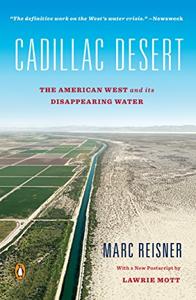
Want to learn the ideas in Cadillac Desert better than ever? Read the world’s #1 book summary of Cadillac Desert by Marc Reisner here.
Read a brief 1-Page Summary or watch video summaries curated by our expert team. Note: this book guide is not affiliated with or endorsed by the publisher or author, and we always encourage you to purchase and read the full book.
Video Summaries of Cadillac Desert
We’ve scoured the Internet for the very best videos on Cadillac Desert, from high-quality videos summaries to interviews or commentary by Marc Reisner.
1-Page Summary of Cadillac Desert
Overall Summary
Cadillac Desert by Marc Reisner is a book about the water supply in the American West. It was published in 1986 and has been praised by many people, including The Modern Library, National Book Critics’ Circle Award, and PBS (Public Broadcasting Service). There’s also a 1993 edition with updates on Western water issues.
The book’s title, Cadillac Desert: The American West and Its Disappearing Water, contains an ideological dualism in that one word stands for luxury while the other describes a harsh environment. This revisionist history focuses on our desire to constantly expand into the desert and how we built water projects such as dams and aqueducts to allow us to do so. Reisner condemns America’s obsession with asserting control over nature, determining that it has led to many environmental disasters, the deterioration of some of America’s greatest bodies of water, and destruction of rural communities (especially Native American communities).
The opening chapters of the book explore how the American West was settled, including a Spanish conquistador who stumbled upon land while looking for gold. Later on in those same chapters, Reisner talks about Powell Geographic Expedition and other expeditions that explored the desert. From these first two chapters, it’s clear that Americans haven’t conquered the desert; rather, we’re living together with an uneasy truce that is turning against us because our communities and farmland are unsustainable.
In Chapter 2-4, Reisner examines the history of water projects in California. He shows how politics and money have influenced water policy in the West. One example is Los Angeles’ theft of Owens Valley’s water, which led to a loss for both parties involved. The Colorado River has been damaged by agricultural and irrigation operations with no regard for their economic or environmental impact.
The Great Depression and World War II had an impact on the development of water projects. The main goal was to increase America’s global power, but they ended up creating two agencies: the Bureau of Reclamation and the Corps of Engineers. These agencies were led by people who were so focused on their own goals that they didn’t care about environmental concerns. As a result, many environmentally damaging projects resulted from these agencies’ rivalry with each other.
In the past, various politicians have tried to curb water distribution policies. For example, Jimmy Carter’s administration attempted to stop these practices but failed. Western politicians who feared that the next drought could be disastrous undermined those attempts. The Central Arizona Project and California’s State Water Project are examples of this; they convinced people that expensive water projects were necessary for their states’ survival despite evidence suggesting otherwise. In addition, there was a tragic dam failure in Teton Dam due to poor construction techniques used at the time (the book does not state when this occurred). Despite these failures and other consequences (which are discussed later), there is still a desire for more dams and ways to divert water from one place to another even though it may seem like we’re trying to conquer nature itself—and failing miserably.
Cadillac Desert: The American West and Its Disappearing Water is a book written by Marc Reisner. He explains that we have no control over the desert, and if we don’t realize this fact, then our greed will cause more conflicts over water resources.
Introduction: “A Semidesert with a Desert Heart”
In the late 1970s, Marc Reisner flew over Utah. He saw how empty it was without any sign of life or towns. However, as he flew over the Wasatch Range, he could see lights from several cities in northern Utah where most of its residents lived. The Mormons were led by Brigham Young to settle this region and build a civilization there. They built irrigation systems that allowed them to grow crops in the desert and live comfortably despite harsh conditions like hot summers and cold winters with little rain.






